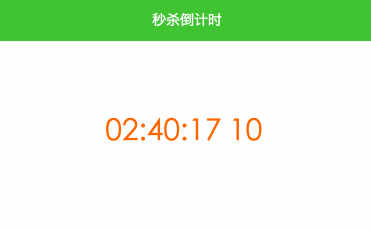
This article mainly introduces the relevant information about the implementation code of the countdown component of the WeChat applet. Friends in need can refer to the following
Functions: Suitable for limited-time group purchases, product flash sales, etc. in e-commerce applications
Let’s take a look at the final effect first:

function countdown(that) {
var second = that.data.second
if (second == 0) {
// console.log("Time Out...");
that.setData({
second: "Time Out..."
});
return ;
}
var time = setTimeout(function(){
that.setData({
second: second - 1
});
countdown(that);
}
,1000)
}
Page({
data: {
second: 3
},
onLoad: function() {
countdown(this);
}
});/* 秒级倒计时 */
function countdown(that) {
var second = that.data.second
if (second == 0) {
that.setData({
second: "Time out!",
micro_second: "micro_second too."
});
clearTimeout(micro_timer);
return ;
}
var timer = setTimeout(function(){
that.setData({
second: second - 1
});
countdown(that);
}
,1000)
}
/* 毫秒级倒计时 */
// 初始毫秒数,同时用作归零
var micro_second_init = 100;
// 当前毫秒数
var micro_second_current = micro_second_init;
// 毫秒计时器
var micro_timer;
function countdown4micro(that) {
if (micro_second_current <= 0) {
micro_second_current = micro_second_init;
}
micro_timer = setTimeout(function(){
that.setData({
micro_second: micro_second_current - 1
});
micro_second_current--;
countdown4micro(that);
}
,10)
}
Page({
data: {
second: 2,
micro_second: micro_second_init
},
onLoad: function() {
countdown(this);
countdown4micro(this);
}
});<text style="display: block;">second: {{second}}s</text>
<text>{{micro_second}}</text>function dateformat(second) {
var dateStr = "";
var hr = Math.floor(second / 3600);
var min = Math.floor((second - hr * 3600) / 60);
var sec = (second - hr * 3600 - min * 60);// equal to => var sec = second % 60;
dateStr = hr + ":" + min + ":" + sec;
return dateStr;
}
目前有2个时钟,影响性能,合并下去掉countdown,于是countdown4micro变成以下的样子:
function countdown4micro(that) {
var loop_second = Math.floor(loop_index / 100);
// 得知经历了1s
if (cost_micro_second != loop_second) {
// 赋予新值
cost_micro_second = loop_second;
// 总秒数减1
total_second--;
}
// 每隔一秒,显示值减1; 渲染倒计时时钟
that.setData({
clock:dateformat(total_second - 1)
});
if (total_second == 0) {
that.setData({
// micro_second: "",
clock:"时间到"
});
clearTimeout(micro_timer);
return ;
}
if (micro_second_current <= 0) {
micro_second_current = micro_second_init;
}
micro_timer = setTimeout(function(){
that.setData({
micro_second: micro_second_current - 1
});
micro_second_current--;
// 放在最后++,不然时钟停止时还有10毫秒剩余
loop_index ++;
countdown4micro(that);
}
,10)
}/**
* 需要一个目标日期,初始化时,先得出到当前时间还有剩余多少秒
* 1.将秒数换成格式化输出为XX天XX小时XX分钟XX秒 XX
* 2.提供一个时钟,每10ms运行一次,渲染时钟,再总ms数自减10
* 3.剩余的秒次为零时,return,给出tips提示说,已经截止
*/
// 定义一个总毫秒数,以一分钟为例。TODO,传入一个时间点,转换成总毫秒数
var total_micro_second = 2 * 1000;
/* 毫秒级倒计时 */
function countdown(that) {
// 渲染倒计时时钟
that.setData({
clock:dateformat(total_micro_second)
});
if (total_micro_second <= 0) {
that.setData({
clock:"已经截止"
});
// timeout则跳出递归
return ;
}
setTimeout(function(){
// 放在最后--
total_micro_second -= 10;
countdown(that);
}
,10)
}
// 时间格式化输出,如3:25:19 86。每10ms都会调用一次
function dateformat(micro_second) {
// 秒数
var second = Math.floor(micro_second / 1000);
// 小时位
var hr = Math.floor(second / 3600);
// 分钟位
var min = Math.floor((second - hr * 3600) / 60);
// 秒位
var sec = (second - hr * 3600 - min * 60);// equal to => var sec = second % 60;
// 毫秒位,保留2位
var micro_sec = Math.floor((micro_second % 1000) / 10);
return hr + ":" + min + ":" + sec + " " + micro_sec;
}
Page({
data: {
clock: ''
},
onLoad: function() {
countdown(this);
}
});



